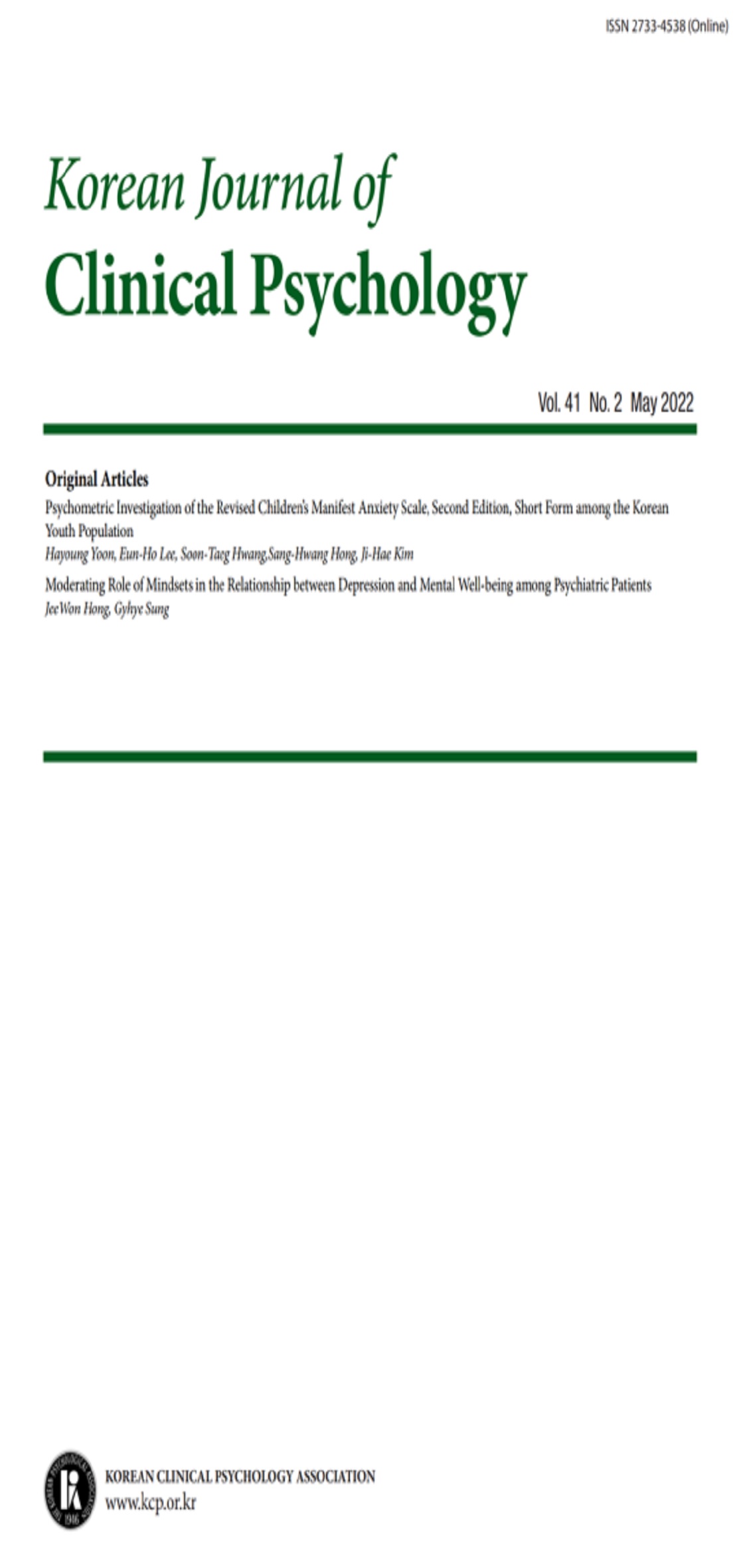open access
메뉴
open access
메뉴 E-ISSN : 2733-4538
E-ISSN : 2733-4538
본 연구는 심리진단과 치료 현장에서 시각주의력에 비해 상대적으로 적은 연구와 활용이 이루어지고 있으나 최근 연구 결과들에 의하면 아동 및 청소년 인지기능에 보다 강력한 영향을 미친다고 보고되고 있는 청각주의력에 초점을 두고 청각주의력의 영향력을 분석해 보고자 하였다. 2004년부터 2006년까지 서울시내 상담센터를 방문한 44명의 지능검사와 시각과 청각 주의력 검사 결과를 가지고 상관분석과 단계적 회귀분석을 실시하였다. 분석 결과, 청각주의력과 소검사간 상관이 시각주의력과 소검사간 상관에 비해 월등하게 우세하였으며 시각주의력과 유의미한 상관을 보인 지능 소검사는 4개에 불과하였다. 단계적 회귀분석 결과에서도 청각주의력이 전체지능과 언어성 지능 및 동작성 지능을 유의미하게 설명하는 예측변인으로 나타났다. 본 연구 결과를 분석하면서 연구자는 교차부호화과정의 영향, 청각주의력 과제의 높은 난이도와 청각주의력과 정서적 변인과의 관련성의 가능성에 대해 제기하였다. 본 연구가 추후 보다 세분화되고 정교한 평가도구와 인지 교정치료 프로그램 개발에 활용될 것으로 기대되었다.
This study aimed to analyze the influence of the auditory attention on childrens’ and adolescent’s cognitive function. It has been recently reported that auditory attention has great impact on children’s & adolescents’ cognitive functions, although this has been studied less and the findings applied less to psychological assessment and intervention than has visual attention. The analysis (correlation analysis and stepwise multiple regression) was done using the data from 44 subjects who visited and underwent psychological testing at center in Seoul between 2004 and 2006., The correlation results showed the auditory attention on the CPT has strong relationships with the overall IQ subtests, but visual attention on the CPT has significant relationships with only 4 IQ subtests. On the stepwise multiple regression analysis, auditory attention was a significant predictor of the total IQ, the verbal IQ and the performance IQ. In conclusion, this researcher suggests that these results might be caused by the transcoding processing effect, the difficulty of the auditory attention task as compared to the visual attention task and the close connection between auditory attention and the emotional aspect. It is expected this reporting can be applied to the development of more refined and elaborated assessment tools and a cognitive enhancement program in the future.
곽금주, (2001) K-WISC-III 지침서, 특수교육
오수성 ; 박상학 ; 김정호 ; 오상우 ; 김상훈 ; 김학렬, (2005) KEDI-WISC와 K-WISC-III 의 구조 및 측정 동일성 검증: 임상표본을 대상으로, 한국심리학회지 임상
손정우, (2003) 시각주의력과 청각자극 주의력의 차이를 보이는 산만한 아동의 행동패턴 연구, 충북의대학술지
신민섭, (1999) 주의장애 진단시스템, 아이큐빅
정운기 ; 최중옥, (2003) PREP의 연속처리훈련이 경도정신지체아의 단어재인능력에 미치는 효과, 특수교육학연구
한국교육개발원, (1991) KEDI-WISC 검사요강, 특수교육
Aylward, G., (2002) Relations between visual and auditory continuous performance tests in clinical population: A Descriptive Study, Developmental Neuropsychology
Benedict, R. H. B., (2002) Covert Auditory Attention generates activation in the rostral/dorsal Anterior Cingulate Cortex. Journal,
Berman R. A., (2002) Auditory and visual attention modulate motion processing in area MT, Cognitive Brain Research
Bregman, A. S., (1990) Auditory Scene Analysis. The Perceptual Organization of Sound, MIT Press
Bush, G., (2000) Cognitive and emotional influences in anterior cingulate cortex, Trends in Cognitive Science
Cohen-Mimran, R., (2007) Auditory temporal processing deficits in children with reading disabilities, Dyslexia
Elliot, L. L., (1989) Fine-grained auditory discrimination in normal children and children with language-learning problems, Journal of Speech and Hearing Research
Facoetti, A., (2003) Auditory and visual automatic attention deficits in developmental dyslexia, Brain Research Cognitive Brain Research
Mahone, E. M., (2005) Construct validity of the auditory continuous performance test for preschoolers, Developmental Neuropsychology
Onat, S., (2007) Integrating audiovisual information for the control of overt attention, Journal of vision
Riccio, C. A., (1993) Developmental language disorders: Relationship with learning Disability and attention deficit hyperactivity disorder, School Psychology Review
Shinn-Cunningham, B. G. , (2008) Object-based auditory and visual attention, Trends in Cognitive Science
Stuart, T. Wrigly, A Model of Auditory Attention. Technical Report CS-00-07,
